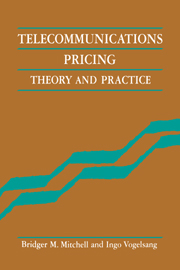Book contents
- Frontmatter
- Contents
- List of figures
- List of tables
- Acknowledgments
- I PRICING AND TELECOMMUNICATIONS
- II RECENT DEVELOPMENTS IN THE NORMATIVE ECONOMIC THEORY OF TARIFFS
- 3 Types of tariffs
- 4 Linear tariffs
- 5 Nonlinear tariffs
- 6 Cost-based tariffs
- III TELEPHONE RATE STRUCTURES IN THE UNITED STATES
- IV SYNTHESIS
- A US telephone price indexes
- Bibliography
- Index
- Selected list of RAND books
5 - Nonlinear tariffs
Published online by Cambridge University Press: 28 October 2009
- Frontmatter
- Contents
- List of figures
- List of tables
- Acknowledgments
- I PRICING AND TELECOMMUNICATIONS
- II RECENT DEVELOPMENTS IN THE NORMATIVE ECONOMIC THEORY OF TARIFFS
- 3 Types of tariffs
- 4 Linear tariffs
- 5 Nonlinear tariffs
- 6 Cost-based tariffs
- III TELEPHONE RATE STRUCTURES IN THE UNITED STATES
- IV SYNTHESIS
- A US telephone price indexes
- Bibliography
- Index
- Selected list of RAND books
Summary
The consumption framework
Nonlinear tariffs involve price discrimination in the sense that different units of a homogeneous output are sold at different prices. They share with linear price discrimination the property that nonlinear tariffs can only be used under certain market conditions. In particular, the supplying firm has to have some market power; perfect arbitrage (resale without transaction costs) must not be possible; customer purchases have to be monitored; and disaggregated demand data have to be available.
In order to analyze linear tariffs in Chapter 4, in either a multiproduct or a peak-load context, it was sufficient to know properties of market demand curves (including cross elasticities between services or time periods). Nonlinear and optional tariffs, however, can only be analyzed with additional knowledge about individual demand curves. This is so because price p now becomes dependent on the quantity q purchased by an individual consumer: there is a price schedule p(q) leading to an outlay schedule R(q) with p(q) ≡ dR/dq = Rf'(q). Since it is entirely unrealistic for a supplier or for a social planner to know the individual demand curves of all customers and since calculation of optimal nonlinear prices becomes extremely complicated even with this knowledge, some regularity assumptions have to be made and new types of aggregation procedures have to be devised.
The now conventional approach in the literature has been to assume that individual demand curves do not cross and that consumers can be characterized by a single-dimensional type parameter τ.
- Type
- Chapter
- Information
- Telecommunications PricingTheory and Practice, pp. 73 - 117Publisher: Cambridge University PressPrint publication year: 1991
- 1
- Cited by



